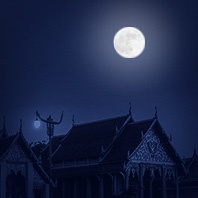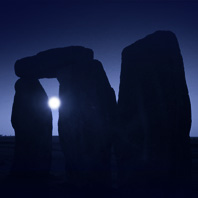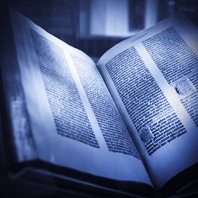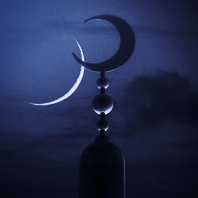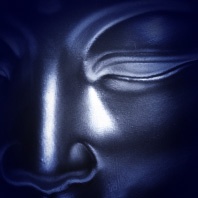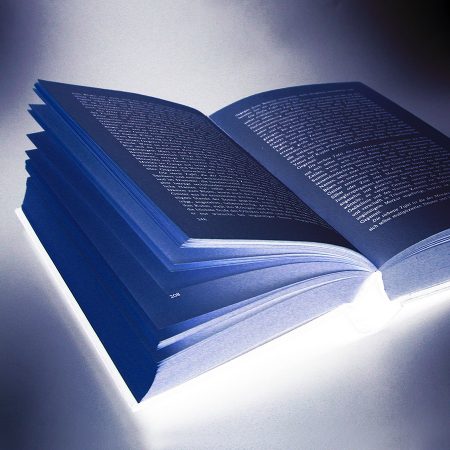Tag:
Religion
Māgha Pūjā is an important Buddhist holiday that is celebrated in Thailand, Laos, Cambodia, and Sri Lanka, on the day of the full moon, in the third month of the Thai moon calendar, in February/March. The word Māgha refers to month and Pūjā is the honoring. Legend has it that on this day 1,250 monks congregated to meet with Buddha.
Read more
»The Woman of the Apocalypse« is a depiction of a Virgin Mary that is surrounded by sunrays (hence she is also called sun-crowned Madonna), and shows a moon crescent underneath her feet. Quite often stars can also be seen around her head. This portrait goes back to the biblical text »The Woman and the Dragon« in the Revelation of John, chapter 12. This describes the fight of heaven against the red dragon that embodies the evil in the world.
Read more
We have already searched and found the word »full moon« in the Bible, but only in two places in the Old Testament (Psalm 81:3–4 and Proverb 7:18–20). This is surprising, because the Last Supper of Jesus and his disciples must have taken place during the full moon, and hence, should have been mentioned in the New Testament.
We have extended our research and have looked for the word »moon« in the Bible. Here too, most passages can be found in the Prophetic books and Psalms of the Old Testament. However, there are also two places in the New Testament in the Gospel of Luke and Mark.
Read more
Just like with all natives from different countries and continents, the Moon also plays an important role amongst African peoples in myths and stories. In this respect, we have already mentioned other peoples, for example the Native American Indians in America, the Inuit in the far north or the Aborigines in Australia.
Read more
In June or July of each year, students commemorate their spiritual teachers (Gurus) with a big festival in India, but also in many parts of Asia. This festival is always celebrated at a full moon (Purnima):
3rd July 2012 [*]
22nd July 2013
12th July 2014
31st July 2015
In Hinduism, this day is also dedicated to the wise Vyasa who is connected to vital Indian writings, like the Vedas, a significant collection of religious scripts.
.
Read more
Shortly before Easter, we are taking a look at Christianity and notice that a very important event must have taken place at the full moon: the Last Supper of Jesus and his disciples. From a historical point of view, the Last Supper derives from the Jewish Passover feast (Seder), which traditionally takes place on the eve of Passover. This meal is being celebrated on the 14th Nisan, which is always the first full moon after the spring equinox – the beginning of spring. This is how later, the calculation of the Easter date had been determined: »Easter takes place on the Sunday after the first full moon in spring.«
Read more
Everyone is familiar with the silhouette of the Stonehenge rocks in the southern English county of Wiltshire, one of the truly ancient structures of human kind that continues to fascinate because of its archaic construction and mystical presence. Maybe it reminds us people of our origin and of something we often tend to forget amid our hectic everyday world: simplicity.
At the same time, the building of Stonehenge has been everything but easy back then. The age of the grounds is estimated to be more than 5000 years. Experts assume, it took many millions of working hours to dress and transport the up to 50 tons heavy rocks by hand and to erect them in the well-known formation. In particular the lintels, on top of the upright stones, leave us in awe.
Read more
The Bible is undoubtedly one of the most important books in human history – most printed, most translated and worldwide the most widespread. It is the Holy Scripture of Christianity and Judaism (in different forms) and therefore the manifestation of God’s word in two of the major world religions.
The text contains, with its archaic, poetic language, many descriptions of nature and celestial events. So, it is obvious that the Sun, the Moon and the stars are mentioned. But is the full moon also to be found?
Read more
As a general rule, we live our secular life by a so-called solar calendar, the Gregorian calendar, which determines our calculation of time since the end of the 16th century. The biggest advantage of a solar calendar is its connection to the seasons: it is warm in summer, cold in winter, at least this is how it should be … at times however, as we all know, the weather goes crazy and sunshine is long-awaited in summer and snow stays away in winter. The seasons are connected to the (solar) calendar months.
Read more
The full moon in May is a special day for many Buddhists, as the Vesak day is celebrated worldwide. According to tradition, Buddha was born on full moon in May, later became enlightened and also passed away on this day. This is how this day is honoured in countries like Singapore, Vietnam, Thailand, Indonesia and also in India, Nepal, Sri Lanka and many more. And above all of this, the full moon shines.
Read more
